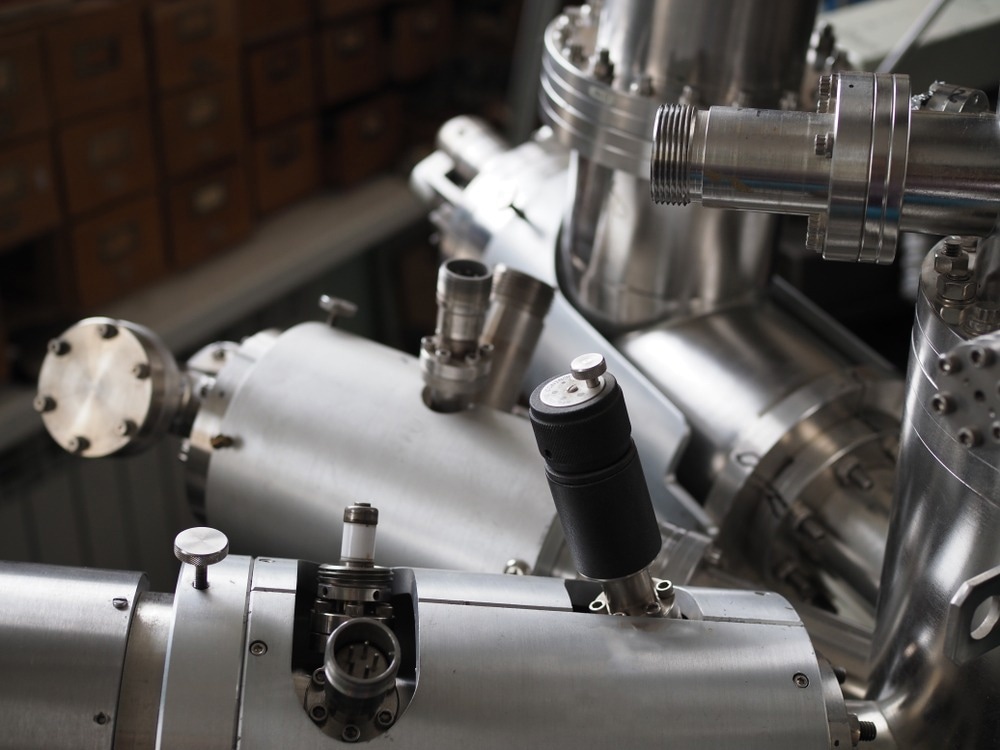The complete characterization of a sample for its chemical composition, morphology, and structure in three dimensions (3D) at the nanoscale range is quintessential for scientific progress in any field. This calls for an appropriate instrumentational solution to meet the characterization requirements.

Study: Magnetic Sector Secondary Ion Mass Spectrometry on FIB-SEM Instruments for Nanoscale Chemical Imaging. Image Credit: White_Fox/Shutterstock.com
In an article recently published in the journal Analytical Chemistry, a magnetic sector secondary ion mass spectrometry was integrated with a focused ion beam (FIB)–scanning electron microscopy (SEM) instruments for nanoscale investigations. A layout of the FIB-SEM instrument combined with secondary ion mass spectrometry was presented, and its performance was evaluated using various samples.
The results revealed that the integrated system showed above 40% of an overall secondary ion beam transmission with more than 400 mass resolving power (M/ΔM), a lateral resolution mode of 15 nanometers in a two-dimensional (2D) imaging, and approximately 4 nanometers depth resolution at beam landing energy of 3-kilo electronvolts.
Furthermore, the magnetic sector secondary ion mass spectrometry integrated FIB-SEM system was tested in photovoltaics, battery research, multilayered samples, and other life science applications. Thus, the integrated system of the secondary ion mass spectrometry showed versatile application in conducting high-performance studies in the life and material sciences.
Secondary Ion Mass Spectrometry Integrated Systems
The development of new characterization and imaging technologies helps derive chemical and structural information at the nanoscale range. Moreover, integrated characterization instruments with imaging features result in robust and complex electronic devices with high lateral resolution and enable the recording of biological specimen’s subcellular chemical information to understand the physiological processes.
An integrated system with a high-resolution electron beam and FIB columns provides excellent chemical sensitivity, high spatial resolution, isotopic selectivity, and high dynamic range. In addition to FIB sample preparation and nanofabrication, secondary SEM imaging can also be performed in a single tool with such integrated systems.
Secondary ion mass spectrometry is a highly sensitive analytical technique that enables the detection of various elements while differentiating between isotopes. Although integration of secondary ion mass spectrometry with FIB instruments has been in practice since the 1980s, its integration with FIB-SEM instruments is a recently discovered approach.
Substituting the secondary ion mass spectrometry with time-of-flight (TOF) spectrometry is one of the approaches to performing secondary ion mass spectrometry on FIB-SEM instruments, wherein the secondary ion (SI) beam is pulsed in orthogonal TOF (o-TOF). Quadrupole spectrometry is a type of secondary ion mass spectrometry used on FIB-based instruments that enable the simultaneous detection of positive and negative secondary ions. However, the quadrupole spectrometers equipped with FIB instruments are unsuitable for fast chemical imaging.
Secondary Ion Mass Spectrometry on FIB-SEM Instruments
In the present study, the FIB-SEM instrument was integrated with a newly developed compact secondary ion mass spectrometry with a double-focusing magnetic sector wherein the vertically oriented SEM column was incorporated with a field emission source and allowed electron beam landing energies from 200 electronvolts to 30 kilo electronvolts. This integrated system offered lateral resolution imaging in SEM mode, chemical/elemental analysis with high sensitivity and dynamic range in secondary ion mass spectrometry mode, and isotopic analysis.
The secondary ion mass spectrometry system was operated for recording 2D and 3D chemical imaging, mass spectra, multiple 2D chemical maps stacking obtained by layer-by-layer removal of sample material, and depth profiling. The capabilities of secondary ion mass spectrometry integrated systems paved the way for wide applications from highly sensitive analytics, secondary ion mass spectrometry imaging with high lateral resolution, and FIB nanofabrication with in situ process control.
Additionally, the secondary ion mass spectrometry system integrated with the FIB-SEM instrument could be applied to correlate secondary ion mass spectrometry data with secondary electron (SE) images, backscattered electron (BSE) data, and energy-dispersive X-ray (EDX) spectroscopy data.
Conclusion
To conclude, a magnetic-sector double-focusing secondary ion mass spectrometry system was integrated with a dual-beam instrument to develop a robust and complex integrated system that can facilitate characterization and imaging simultaneously.
In the optimized configuration, the extraction optics in the secondary ion mass spectrometry system were retractable and were incorporated directly above the sample surface for the operations using the secondary ion mass spectrometry system. This configuration achieved the highest sensitivity due to the high secondary ion extraction efficiency. The FIB-SEM- secondary ion mass spectrometry integrated system is multifunctional and can generate 2D or 3D images, mass spectra, and depth profiles.
The mass spectra were recorded in the range of 1 to 400 atomic mass units with a mass resolving power of above 400 and a high dynamic range, enabling isotopic selectivity. The secondary ion mass spectrometry imaging results enabled the high-resolution chemical maps recording with 15 nanometers of lateral resolution.
Reference
De Castro, O., Audinot, J. N., Hoang, H. Q., Coulbary, C., Bouton, O., Barrahma, R., Ost, A et al. (2022). Magnetic Sector Secondary Ion Mass Spectrometry on FIB-SEM Instruments for Nanoscale Chemical Imaging. Analytical Chemistry. https://doi.org/10.1021/acs.analchem.2c01410
Disclaimer: The views expressed here are those of the author expressed in their private capacity and do not necessarily represent the views of AZoM.com Limited T/A AZoNetwork the owner and operator of this website. This disclaimer forms part of the Terms and conditions of use of this website.